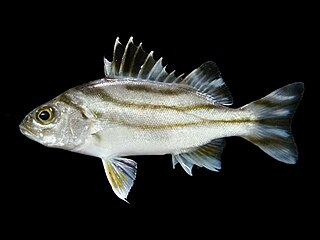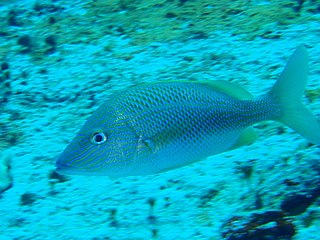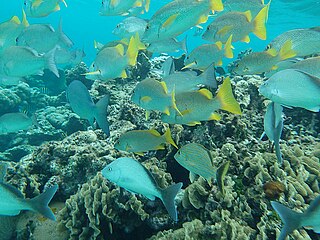
The Caesar grunt, also known as the black grunt, blacktail grunt, or redmouth grunt is a species of marine ray-finned fish, a grunt in the family Haemulidae. It is native to the western Atlantic Ocean

The slippery dick is a species of wrasse native to shallow, tropical waters of the western Atlantic Ocean.

The brownstriped grunt, also known as the burro, is a species of marine ray-finned fish, a grunt belonging to the family Haemulidae. It is native to the western Atlantic Ocean.

The mutton snapper is a species of marine ray-finned fish, a snapper belonging to the family Lutjanidae. It is found in the Western Atlantic Ocean.

The Indian Ocean oriental sweetlips, also known as the oriental sweetlips or oriental blubberlips, is a species of marine ray-finned fish, a sweetlips belonging to the subfamily Plectorhinchinae, one of two subfamilies in the family Haemulidae, the grunts. It is native to the Indian Ocean and the western Pacific Ocean.

Terapon jarbua, the jarbua terapon, crescent grunter, crescent banded grunter, crescent perch, spiky trumpeter, thornfish or tiger perch, is a species of ray-finned fish, a grunter of the family Terapontidae. It occurs in the Indo-Pacific. it is an important commercial species within its range and is sometimes found in the aquarium trade where it is known as "target fish" for the pattern visible from above.

Anisotremus virginicus, the porkfish, also known as the Atlantic porkfishsweetlips, dogfish or paragrate grunt, is a species of marine ray-finned fish, a grunt belonging to the family Haemulidae. It is native to the western Atlantic Ocean.

Haemulon vittatum, the boga, is an ocean-going species of grunt native to the western Atlantic Ocean. Bogas are also known as the snit in Jamaica, and bonnetmouth in the Bahamas. It was first described by Cuban zoologist Felipe Poey. This species used to be classified as Inermia vittata, but genetic data revealed that it belongs to the genus Haemulon.
Emmelichthyops atlanticus, the bonnetmouth, is a marine fish species of grunt native to the western Atlantic Ocean, where it occurs from Florida and the Bahamas to northern South America. This species is the only known member of its genus.

The bluestriped grunt, also known as the boar grunt, golden grunt, humpback grunt, redmouth grunt, or yellow grunt, is a species of marine ray-finned fish, a grunt belonging to the family Haemulidae. It is found in the western Atlantic Ocean.

Haemulon flavolineatum, the French grunt, banana grunt, gold laced grunt, open-mouthed grunt, redmouth grunt, or yellow grunt, is a species of marine ray-finned fish, a grunt belonging to the family Haemulidae. It is native to the western Atlantic Ocean.

The yellowhead wrasse is a fish species belonging to wrasse family native to shallow tropical waters in the Caribbean Sea and western Atlantic Ocean.

Haemulon plumierii, the white grunt or common grunt, is a species of ray-finned fish in the family Haemulidae native to the western Atlantic Ocean. It grows to a length of about 30 cm (12 in) and is a silvery-cream color, with narrow yellow and blue longitudinal stripes, but can modify its color somewhat to match its surroundings. It is closely related to the bluestriped grunt and the French grunt, and often schools with these species. It feeds on shrimp, other crustaceans, annelids, and mollusks, and is preyed on by larger piscivores such as barracuda and shark. It is sometimes caught by anglers as a game fish, and its flaky white flesh can be eaten. It is also a popular aquarium fish.

Haemulon is a genus of fish in the grunt family known as the scaled-fin grunts. Most are found in the western Atlantic Ocean, with a few species known from the eastern Pacific Ocean. This genus is considered to be one of the most important fish groups of the coral reefs of Brazil due to its commercial value and crucial ecological role.

The black margate, also known as black bream, black thicklip, dogfish, lippe, Mexican bull, pompon, Spanish grunt, surf bream, sweetlips or thicklip grunt, is a species of marine ray-finned fish, a grunt belonging to the family Haemulidae. It is native to the western Atlantic Ocean.

Sparisoma aurofrenatum is a species of parrotfish native to the Caribbean Sea and Western Atlantic Ocean.

Haemulon chrysargyreum, the smallmouth grunt, bronze grunt, or yellowstripe grunt, is a species of marine ray-finned fish, a grunt belonging to the family Haemulidae. It is found in the western Atlantic Ocean.

Haemulon scudderii, the grey grunt, golden-eye grunt, or mojarra grunt, is a species of marine ray-finned fish, a grunt belonging to the family Haemulidae. It is found in the eastern Pacific Ocean.

Haemulon album, the white margate, grey grunt, grunt, Margaret fish, Margaret grunt, margate, margate fish, ronco blanco, viuda, white grunt, white pogret, or yellow grunt is a species of ray-finned fish, a large grunt belonging to the family Haemulidae. It is native to the western Atlantic Ocean.

Haemulon melanurum, the cottonwick grunt, is a species of ray-finned fish within the family Haemulidae. The species is found inhabiting tropical waters in the western Atlantic near parts of North and South America. The species can grow to a maximum length of 43.5 centimeters, however individuals are most commonly found at lengths of 25 centimeters. The maximum published weight of the species was 550 grams. Adults are silver in coloration with narrow yellow stripes running along the body, with a bronze line in front of the eye. Adults also possess a black line running from the beginning of the dorsal fins to the caudal fins. It is an oviparous schooling fish that feeds on crustaceans.



















